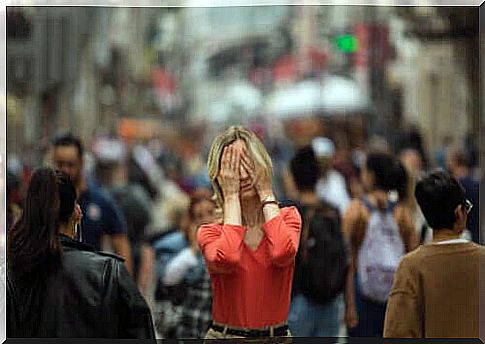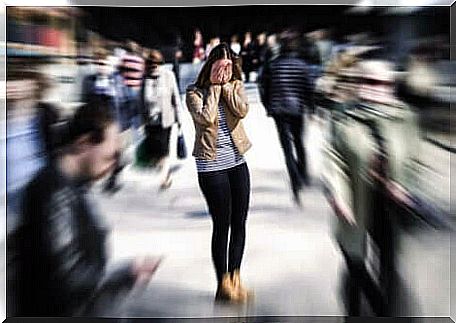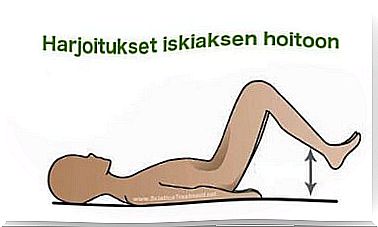What Are The Symptoms Of Agoraphobia?

Many different parties have taken on the task of describing the symptoms of agoraphobia, but in all cases it has emerged that it is a rather complex disease that each person experiences differently. If we were to classify it, we would classify it as an anxiety disorder.
People with agoraphobia feel anxiety or exaggerated fear of places or situations where they feel defenseless, trapped, or ashamed. This can include, for example, spacious spaces, a large crowd or even public transport. Agoraphobia is more commonly known as the dread of public or open spaces.
The problem here is that the symptoms of agoraphobia vary widely and sometimes different phobias overlap. In this article, we discuss the most common manifestations of agoraphobia.
Symptoms of agoraphobia according to DSM-V
The DSM-V is a diagnostic and statistical manual for mental disorders, updated in 2013. It is a tool commonly used by psychologists and psychiatrists to identify various illnesses and conditions. According to this handbook, the most common symptoms of agoraphobia are:
- Feeling anxious in places where it can be difficult or embarrassing to try to get out. Patients are usually afraid of having a panic attack or – worse – having it in a place where they can’t get help with it. As a result, crowds outside the home cause them the most distress, such as public transportation or supermarkets.
- This fear means that the patient is beginning to develop avoidant patterns of behavior. For example, if someone feels anxious while traveling by bus, he or she will avoid traveling by bus altogether. He changes his habits for fear of having a panic attack on the bus.
- In order for a definitive diagnosis of agoraphobia to be made, the anxiety attacks must be recurrent or at least one of them must have caused great anxiety or fear to the patient. By this we mean that the person is afraid of having a new scene and as a result changes their behavior from that moment on.
At this stage, it should be emphasized that other mental disorders should be ruled out in order to make an accurate diagnosis. The reason for this is that certain phobias, such as social phobia, are often confused with agoraphobia.

Symptoms of agoraphobia: a few examples
The symptoms of agoraphobia, as we have already mentioned, vary from person to person. Often, this disorder causes fear of being in spacious places, especially when the person is alone. However, it can also occur in enclosed spaces, such as (cinema) theaters.
Agoraphobia is also characterized by fear of being embarrassed. The person suffering from it fears what would happen if he fell to the ground or had a panic attack in front of other people. This fear is usually quite extreme and very intense.
The problem here is that all of this adversely affects every aspect of a person’s life. As we have already mentioned, the patient begins to develop avoidant behavior.
For example, if a person is afraid to travel by public transport to work or another place in their spare time, evasive behavior begins to condition their actions and reactions and prevent them from participating in all kinds of activities.
Other things to consider about agoraphobia
According to an article in Professional Pharmacy , symptoms of agoraphobia usually appear in late adolescence or early adulthood. Most often, a person suffering from agoraphobia increasingly seeks the safety of their home by going outside with only the necessary things.
If this disease is not treated in time, it eventually becomes chronic and feeds itself, becoming quite a crippling affliction. However, we need to keep in mind that this is a panic disorder and for this reason it is also associated with physical symptoms.
An article in the Journal of Psychopathology and Clinical Psychology states that when a panic attack strikes, a person’s heart rate increases, he or she may feel suffocated, sweating increases, and his or her chest squeezes or distresses.
In extreme cases, this can lead to dizziness and fainting. An anxiety attack makes a person feel as if they have lost control, and this can also cause fear of death.

Symptoms of agoraphobia: what to remember about this disorder
We need to keep in mind that agoraphobia is a complex disorder that can manifest in many different ways. People with this disorder are afraid of certain situations, such as traveling by public transport or going to places where they feel they can’t get help when a panic attack strikes.
For this reason, the patient needs appropriate mental support and treatment. Otherwise, the disorder can become chronic and begin to define and control the patient’s life, preventing him or her from living a normal daily life.









